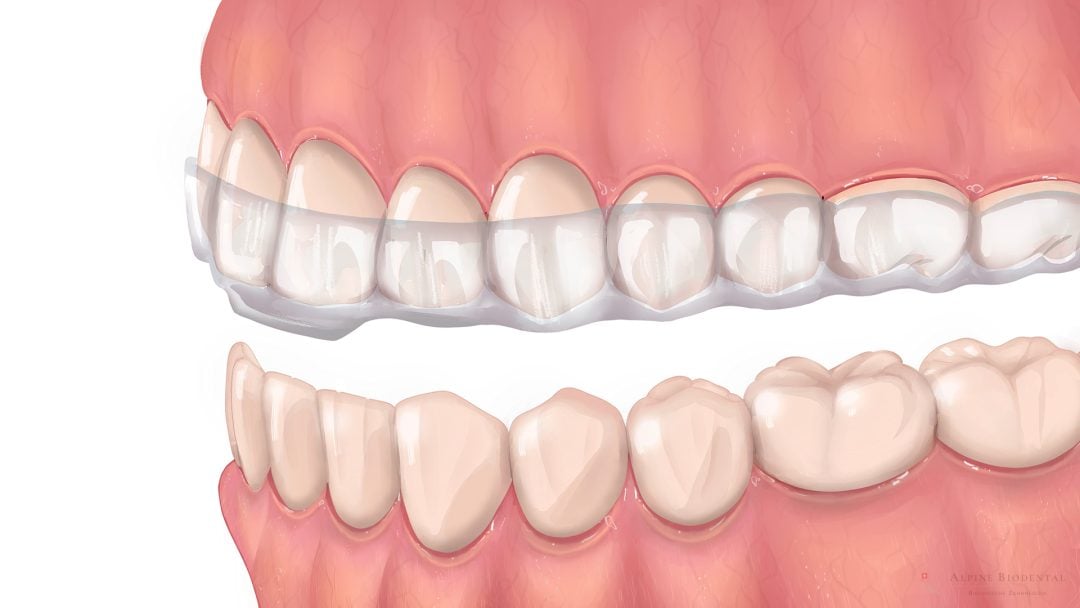TMJ-Splint

A TMJ (temporomandibular disorders of the joints) splint is a transparent dental splint designed to reposition the temporomandibular joints. It is also known as occlusal splint.
The incorrect positioning of the temporomandibular joints typically results from a misaligned bite, forcing the joints into an unhealthy position.
The TMJ splint temporarily resolves the misalignment of the bite. Through the gradual adjustment of the dental splint, the anatomically correct regeneration of the temporomandibular joints is achieved, effectively eliminating symptoms associated with TMJ.
Prerequisites for TMJ Splint Therapy
The primary requirement for offering such treatment in a dental practice is a considerable amount of experience in TMJ therapy. Our team specializes in treating severe TMJ cases and can address complex issues with a causative approach.
It is of utmost importance that the therapy planning is executed accurately, and specialists complement each other ideally to avoid errors in treatment. Oral surgeons, dentists, and dental technicians must work seamlessly together to achieve uncompromised results.
Therapists from other fields, such as integrative Medizin, physiotherapy, osteopathy, speech therapy, posturology, or optometry, may also be considered in the therapy planning process under certain circumstances.
MAGO Splint
The MAGO (Maxillary, Anterior Guided, Orthosis) splint, credited to American biologist and dentist Dr. Robert Lee, is designed to treat the temporomandibular joint disorder. Dr. Robert Lee dedicated his life to studying the masticatory system and developed this type of splint therapy to treat affected patients with a causative approach.
The MAGO splint is capable of reversing the pathological changes in the masticatory apparatus, bringing the tissue into a harmonious and balanced state. It transforms faulty muscle movement patterns into physiological patterns, regenerating the temporomandibular joints into the correct position.
Working with the MAGO splint requires adjustments approximately every 14 days to gradually and gently restructure the tissue. In a few weeks, but typically within three to four months, most patients experience significant relief from TMJ symptoms.
The MAGO therapy is considered complete when there are no more complaints, the masticatory muscles exhibit physiological movement patterns, and the temporomandibular joints are regenerated and stable in the correct position. This usually occurs within six to nine months in most cases.
At Alpine BioDental, we typically address complex cases using the MAGO splint.
Treatment Process
The treatment process with the TMJ splint consists of several steps. The goal of the treatment is to completely eliminate TMJ and maintain the new correct situation throughout a lifetime.
TMJ Consultation
The TMJ consultation is the first step before the treatment can commence. During this appointment, a thorough examination of the teeth, temporomandibular joints, and the entire masticatory system takes place. This TMJ diagnosis is a crucial foundation before the start of therapy.
All treatment options are discussed, and all pros and cons are explained. Subsequently, the therapy with the TMJ splint can be initiated.
TMJ Splint Therapy
During this phase, the temporomandibular joints are completely relieved and gradually guided toward full regeneration. It is necessary to wear the splint 24 hours a day, and adjustments to the splint are made every 2 to 3 weeks.
Once the temporomandibular joints have arrived in the new anatomically correct position, there should be little to no TMJ symptoms.
For the correction and regeneration of the temporomandibular joints, we use the MAGO splint.
Reconstruction of the Bite
Since the temporomandibular joints have regenerated from the unhealthy position to the anatomically correct, healthy position, the bite has consequently changed.
The previously incorrect bite would remain incorrect and, without wearing the TMJ splint, would force the temporomandibular joints back into the old position. Therefore, the next correct step is the reconstruction of the occlusal surfaces to align the bite with the temporomandibular joints.
Reconstruction is achieved using ceramic restorations on the teeth, including inlays/onlays and veneers.
Upon completion of the therapy, the tooth anatomy precisely conforms to the natural specification, and the tooth contacts support the temporomandibular joints in the new correct position.
Duration of Treatment
The treatment with the TMJ splint lasts 3 to a maximum of 12 months, depending on the regenerative capacity of the temporomandibular joints.
It is crucial to wear the splint 24 hours a day and only remove it for brushing teeth. The splint is designed to remain in the mouth even during meals.
Dr. med. dent. Markus Spalek
Accurate CMD therapy requires a wealth of experience. Alpine BioDental specializes in CMD therapy. Feel free to reach out to us.

Further information
The following are the relevant pieces of information listed to provide you with more insight into the topic.